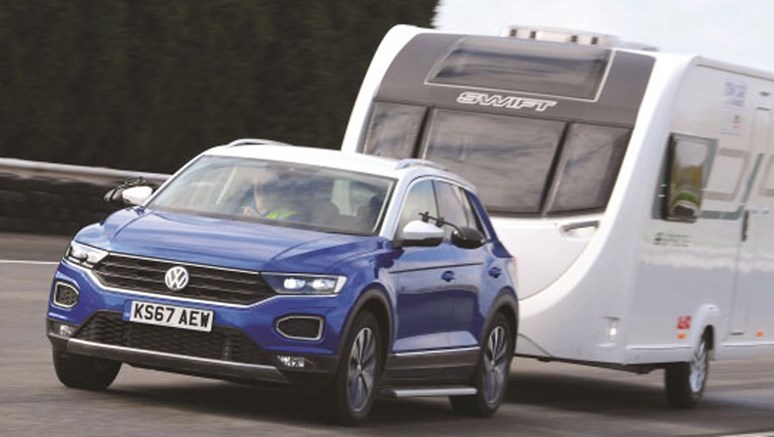A Guide to Towing Safely
Some important safety factors to consider
Before you begin to tow, it is vital to check that your car and trailer combination are correctly matched. This matching covers the safe physical and legal limits to the weight of the caravan that you should tow with your car.
TOWBAR
A well fitted and maintained towbar is vital for safety. It is the main connection between car and trailer. Although the towbar now falls within the remit of the MOT you should inspect the tow bracket regularly, checking for cracking or serious rusting and that the bolts are correctly tightened or get it checked out when the car is serviced.
Detachable towbars should be treated with extra care. Make sure both the housing and bar are clean before fitting. When in place, check there is no excessive movement. If you are uncertain about your towbar, have it checked by a towbar specialist.
TYRES
The only contact your car and caravan have with the road is through the tyres. Look after them and you will improve the safety and behaviour of your unit.
Carry a spare wheel, a compact spare or a tyre sealant kit, check that it is suitable for use when towing. Runflat car tyres are also often not suitable in a deflated condition when you are towing. Further detailed information is provided in our Tyres and tyre care guide. If in doubt contact the Club's technical information helpline.
Check the caravan wheel nuts are tightened to the correct torque, don't forget that overtightening nuts can be as bad as having them too loose.
BRAKES
Brakes are life and death components. Maintenance is best left to properly trained mechanics. It's worth keeping an eye on your brake mechanism and cables. If you have any doubts, have them checked.
ELECTRICS
The road lights on your caravan are operated from the towcar through a standard seven pin (12N) socket and plug or selected pins within the newer 13-pin socket and plug system. Adapter cables are available to link a seven-pin and 13-pin system together.
You must have by law a visual or audible warning on the towcar to show the caravan indicators are working. Traditional systems give a positive indication that work separately from the car system, but now it is more common for caravan indicators to be monitored by the car's bulb failure system.
Before moving off, check all caravan road lighting functions are working.
SUSPENSION
Check the condition of both car and caravan suspension. It's important for safety as well as comfort. When your caravan is attached to your vehicle it should tow level or slightly nose down, preferably not with its nose up. If you find the car rear sags, you may need some form of suspension aid. Get specialist advice on the type required for your car from your car dealer or suspension aid supplier. Further advice is detailed in our guide, Suspension modifications.
Statistics show that caravans are safe and accidents rare, but to ensure your safety it is necessary to consider some important safety factors.
This guide looks at safety factors to consider before you set off and other considerations when on the road to keep you safe.
Many references are to caravans, but this can equally refer to other towed camping units such as a folding camper or trailer tent.
NOSEWEIGHT
Ideally, for stability, the noseweight should be between five and seven per cent of the actual laden weight of the caravan. But the noseweight must also not exceed the car towball limit or the caravan hitch limit, so use the lowest limit which will probably be the car towball limit. If the lowest figure is less than five per cent of the caravan's weight this could compromise stability, so reconsider your choice of towcar.
The caravan noseweight can be adjusted by the amount of equipment stored to the front or rear of the axle. Avoid counteracting a heavy noseweight with weights at the extreme rear of the caravan as this will have a detrimental effect on stability. Noseweight can be checked with a purpose built noseweight gauge (preferably complying with BS7961) or by using bathroom scales.
MIRRORS
The law says you must have mirrors to provide an adequate view to the rear and along both sides of your trailer. If your caravan obscures the view from your rear view mirror, or your caravan is wider than your car, you will need additional external towing mirrors. These should not project more than 200mm (250mm if your towing mirrors are E-marked to the latest standard) beyond your unit's widest points. Its worth noting extra wide caravans will always need towing mirrors and most standard width caravans will need them too. Only large vans or narrow caravans may not need extension mirrors.
Make sure the mirrors are adjusted correctly and extension mirrors, where required, are removed when not towing.
MATCHING
It is important that the abilities of the tow car are compared with the size and weight of the intended caravan. The Club provides a free matching tool for its members to use here. More information on this and other important considerations are in our Matching here.
PAYLOAD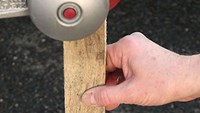
Payload is the weight of items that you are allowed to carry in the caravan for personal use and for essential items such as gas cylinders and battery. You will find the figure in the handbook. Check the loaded weight of your caravan on a public weighbridge or use a weighing device periodically to make sure that you are not exceeding the maximum technically permissible loaded mass - MTPLM.
Alternatively, weigh each individual item on the bathroom scales before loading, but don't forget major weight components like gas cylinders, battery and spare 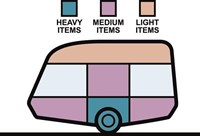 wheel.
wheel.
Sometimes the spare wheel is standard equipment and hence within the unladen weight of caravan or MRO (mass in running order), but otherwise it is an optional extra with its weight coming out of your payload. Remember that fitting a caravan mover adds up to 40kg to the caravan payload and can easily push you over the payload limit.
Overloading can cause failure of vital components such as tyres. The payload should be kept evenly distributed between each side of the caravan noting that cupboards may not be evenly spread out so take this into account when loading. Heavier items should be positioned as close to the axle as possible for maximum stability.
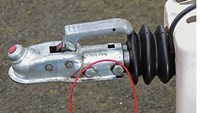 BREAKAWAY CABLE
BREAKAWAY CABLE
Caravans with brakes are legally required to have a breakaway cable fitted. In the unlikely event of the caravan becoming detached from the towcar, the cable will pull on the caravan brakes and then snap allowing the caravan to stop away from the tow vehicle.
It is better to attach the cable via a dedicated mounting point on the towbar rather than around the towball. Make sure there is enough slack in the cable so the brakes are not pulled on when turning.
There are two types of breakaway cable clips available as shown below. The spring clip and the carabiner style.
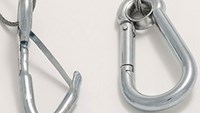 The spring clip type as shown on the left of the image is fitted to most caravans and must be attached to itself in a loop and never directly to the tow bar structure. The carabiner-style clip as shown on the right of the image can be attached directly to the towbar structure and also be used attached to itself so it is far more likely this type of breakaway cable will be correctly attached. From January 2018 the carabiner-style clip will become more commonplace on new caravans and the Approved Workshop Scheme should recommend changing to this type during service.
The spring clip type as shown on the left of the image is fitted to most caravans and must be attached to itself in a loop and never directly to the tow bar structure. The carabiner-style clip as shown on the right of the image can be attached directly to the towbar structure and also be used attached to itself so it is far more likely this type of breakaway cable will be correctly attached. From January 2018 the carabiner-style clip will become more commonplace on new caravans and the Approved Workshop Scheme should recommend changing to this type during service.
As with all breakaway cables it should not drag on the ground, but allow enough free movement that when there is an acute angle between car and caravan the cable is not pulling on the caravan handbrake lever while in use, an easy way to accommodate the slack is to apply a twist or two into the cable as shown below.
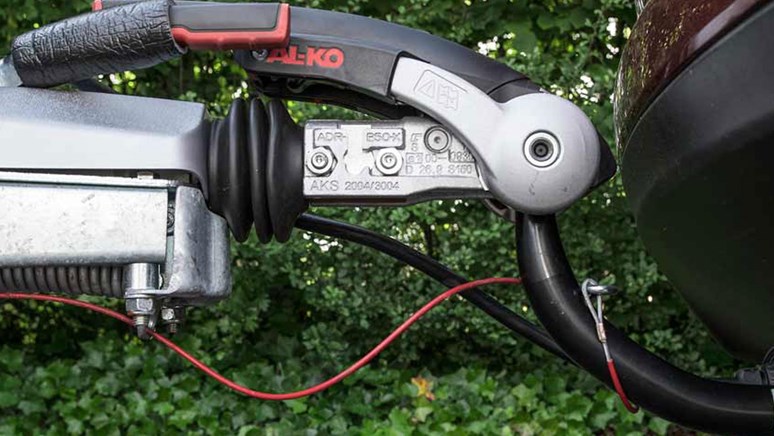
Unbraked trailers up to 750kg are required to have secondary couplings - normally a chain to keep the trailer attached to the towcar if the main coupling fails.
Check this out before setting out
- Internal and external loads are safely secured
- Windows and roof vents are securely closed
- Gas cylinder valves are turned off
- Noseweight is within car and caravan limits
- Steadies and jockey wheel raised and secured
- Coupling head is fully engaged on the car towball
- Breakaway cable/ secondary cable attached correctly
- Handbrake released
- Road lights working correctly
See also the Club's Pre-journey checklists for a handy downloadable aide mémoire caravan, trailers and motorhomes on the technical help pages.
For further information on the use of breakaway cables and coupling up see our video here.
COUPLING
Ensure that the caravan coupling head is fully engaged on the car towball. Often the head will have a coloured indicator to show when engagement is complete, but it is definitely worth winding down the jockey wheel until the back of the car is raised about 25 to 50mm to confirm a secure coupling.
Towing on the road
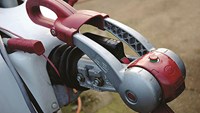 Towing a caravan is no more difficult than driving solo providing you are aware of the length of your unit and the extra weight your car needs to move. There is no reason why your trailer should not dutifully follow your car but you will need to allow more time and space to stop safely, overtake and corner under control.
Towing a caravan is no more difficult than driving solo providing you are aware of the length of your unit and the extra weight your car needs to move. There is no reason why your trailer should not dutifully follow your car but you will need to allow more time and space to stop safely, overtake and corner under control.
CORNERS
On roundabouts and corners your unit will not follow the exact path of your car. You'll need to take a wider path so that the rear of your unit clears the kerb line and other obstructions.
SPEED
Watch your speed, particularly on long down hill stretches. The onset of instability in such circumstances is far more difficult to control than at a more modest speed and when uphill with the car pulling the caravan rather than caravan pushing the car. Remember, the motorway and dual carriageway speed limit when towing a trailer is 60mph which is a maximum and it is sometimes wiser to travel at a lower speed, it saves fuel too. Further information is available at gov.uk/speed-limits.
With a load on the back, acceleration will be slower and you will need more time and space for overtaking. Your combination is longer and wider than your car alone so you will need to take this into consideration before pulling out.
HILL STARTS
Hill starts need more throttle than normal to get going and you will need delicate clutch control to avoid stalling.
BRAKING
When towing it will take you an average of 20 per cent more distance to stop. Avoid violent braking.
INSTABILITY
Snaking is the most common form of instability and is often due to bad loading, inadequate nose weight, excessive speed or incorrect tyre pressures or a combination of factors. Even with well matched units, air turbulence from passing lorries or coaches will often cause some affect on your unit. Take special care when overtaking such vehicles and if possible maintain as much lateral gap as possible with your outfit.
Vertical instability is called pitching and can occur if you hit a pothole. In either case don't apply your brakes. Slow down gradually by easing off the accelerator. A stabiliser may help to avoid instability but must not be a replacement for good car and caravan matching or weight distribution.
Similarly, there are now electronic car and caravan safety systems which can provide benefits in the event of snaking occurring such as ESP (electronic stability program) and TSP (trailer stability program) in cars. The trailer specific program being the better option if available. Where TSP is not available on the towcar then AL-KO's ATC and BPW's iDC systems can be fitted to certain caravans.
TIREDNESS
It can kill. If you are planning a long journey make sure you plan some breaks, government advice is to take a 20 minute break every two hours. Pull off the road for a tea, coffee or other caffeine based drink or perhaps get an hour or two of sleep. It will keep you refreshed and ready to complete your journey.
Be considerate to other road users
- Caravans get more than their fair share of blame for holding up traffic. Towing a caravan or trailer may reduce the speed you would normally travel solo. If this leads to a build up of traffic behind your unit, pull over when it is safe to do so, to allow faster vehicles to pass.
- Don't travel in a convoy.
- Be aware of your speed when going up and down hills. Try not to stop, but use your vehicle's gears wisely.
- Indicate well in advance if you intend overtaking or turning off the highway.
- Always try to anticipate what other drivers are likely to do.
- Allow plenty of space between your car and the vehicle in front.
- Be aware of oncoming traffic especially if a vehicle is indicating to turn across your lane.
- When parking, make sure you do so in a place that will not cause a nuisance to other travellers. If you park on an incline apply both vehicle and trailer handbrakes.
- If you have to reverse, get a helper to keep an eye on the back of your caravan and agree suitable hand signals between you. This is important for the safety of the caravan and pedestrians.
- Reversing around corners can be difficult and almost impossible for small short trailers. If you have problems, unhitch and manhandle the trailer into position - as long as you have enough manpower to do it without injury.
- The Camping and Caravanning Club runs manoeuvring courses that will help increase your confidence when travelling with your unit and positioning it.
Safe off and on the road
In this guide we have dealt with keeping your caravan or trailer safe as a road vehicle. It is also important to consider the safety of your onboard gas and mains electrical systems and appliances.
The Club recommends you have an annual service undertaken by a workshop belonging to the Approved Workshop scheme. These workshops will check out the safety of your habitation systems as well as ensuring your caravan is road worthy.
See our Servicing for more information and visit approvedworkshops.co.uk for details of the nearest Approved Workshop to you.
What the law says
- Caravans and their towing vehicles should be in such a condition that they cause no danger to other road users
- You may drive up to 60mph on motorways and dual carriageways and on all other roads the speed limit is 50mph unless lower limits are in force
- Normal cars (gross vehicle weight not exceeding 3,500kg) may tow a trailer up to a maximum body length of seven metres (not including draw bar) and width not exceeding 2.55 metres. Some imported caravans can be longer
- No special driving licence is required to tow a caravan as long as you have B and BE on your licence. However, a driving licence issued in Northern Ireland since 1st January 1997 may need to take an additional (B+E) test if they wish to have a larger outfit although a family saloon will permit the towing of a reasonable size caravan. Further detailed information regarding driving licence and the limitations can be found in Driving Licences.
- Your trailer must carry a number plate with the registration number of the tow vehicle on it as well as red reflecting trailer triangles
- Passengers are not allowed to travel in a trailer while it is being towed
- You must have a full car driving licence to be able to tow
- In NI if you have your B+E provisional licence and a qualified (BE) driver is in the vehicle you are able to tow
- Towing vehicles must not use the outside lane of a three (or more) lane motorway even when overtaking, unless signs indicate otherwise or the nearside lanes are blocked by roadworks
- Tyres must be capable of carrying the maximum permitted weight of the trailer and have a tread depth of no less than 1.6mm across the central three-quarters of the breadth of the tyre and around the entire circumference
- Stopping overnight in a lay-by may be considered an obstruction. You could be asked to move on.
- If you park your caravan in the street overnight you must not park at parking meters and you must display lights all round
- A trailer must not be left on the road uncoupled from its towing vehicle unless the brake is on or at least one wheel is effectively prevented from moving.
- If you carry anything on your trailer, like a bicycle, the load must be secured and not stick out dangerously.
Advise your insurer
Adding a towbar to a car is classed as a modification that must be declared to the car's insurance provider. If you use The Camping and Caravanning Club's Club Care insurance provider you will automatically be covered, but other companies may make an additional charge. Your car's insurance will then cover any third party damage while you are towing, but you will probably want separate caravan insurance to cover the caravan itself against damage, fire and theft.

